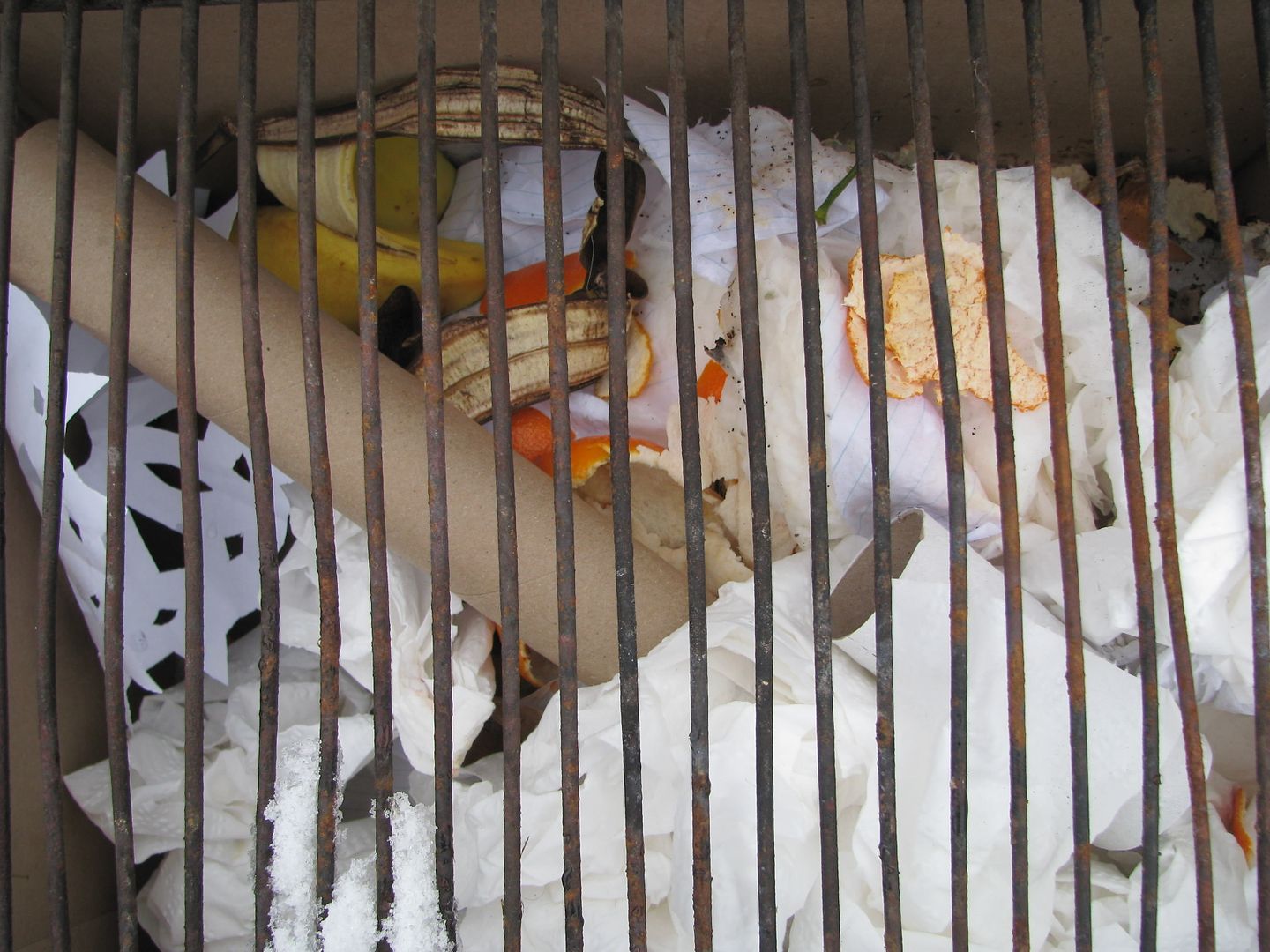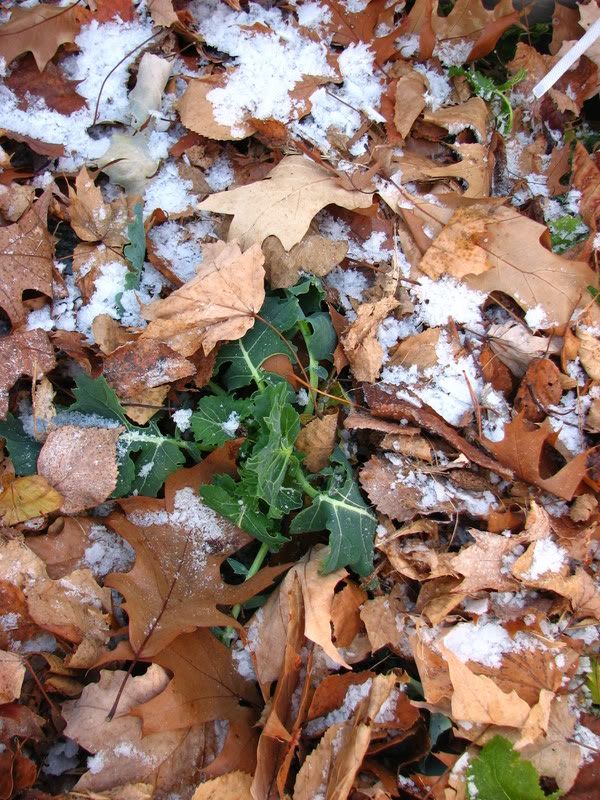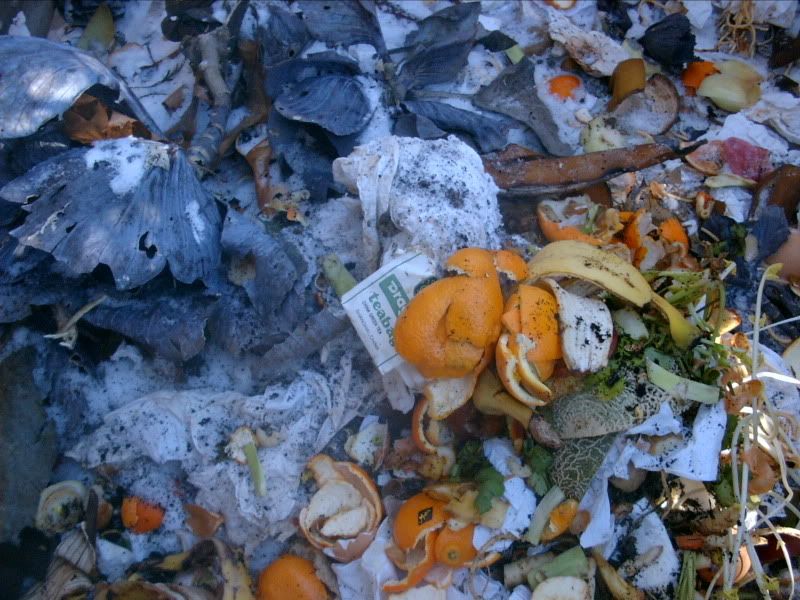
This imprisoned compost is my part of the Compost in a Box project where I am transforming a field into a garden bed by filling boxes with winter compostable waste set side by side. In the spring, I will layer on some more stuff and plant compost loving plants on top like squsah. I'll keep you updated to see if it works.
Everything you wanted to know about Compost but were afraid to ask*
Ah compost, much like making babies, the science of nourishing soil can be so easy you do it by accident or as difficult as a finely tuned experiment. Essentially compost is the byproduct of the breakdown of organic matter by a host of critters to produce the lightly textured, water retentive plant and soil fortifier that is humus.
My little compost in the city
As I am a busy homeschooling mom who works causally as a landscaper and all around Jill of the garden, I tend to prefer the methods with the least amount of input for the highest quality output which makes me favour lump it and leave it composting techniques. In my urban home, I dumped all vegetable scraps, and safe plant waste into a big enclosed pile at the far corner of my yard. By safe, I mean plant waste that was not diseased, and did not contain other spready seeds, roots or other propagating plant parts. I only had room to hide one pile of rotting vegetation so it was used continually all year round. If the pile started to smell, I would shovel on some dirt or add loosely packed dry material. It (almost) never dries out in our climate so that wasn't a problem. In late fall, I would push aside the uncomposted top layer and shovel out the composted bottom half. Some of it was usually half finished in that there were some recognizable remains. This would be used to topdress intensively cultivated areas, or to level off areas where plants were dug out.

Oak Leaves cuddling up to late fall brassicas.
Fall leaves I would leave where they lay on the gardens and collect up with my lawn mower if they fell on my shrinking lawn. They were then used to mulch my garden bed. This is probably close to the laziest way you can compost with the exception of tossing vegetable scraps out the window into the yard.
Compost In Place
However, even the compost pile is optional. Organic matter can be used to help build new garden beds in the topdressing style made popular by folks such as Patricia Lanza of Lasagna Gardening or her predecessor Ruth Stout's straw heavy 'No work, Garden Book.' Generally these gardens are topped with something that can act as a mulch. I've read of several sources than add continually to the garden by tucking vegetable scraps under the mulch. If you have a light fluffy top layer like straw I could see this working.
The Complete Compost gardening guide by Barbara Pleasant and Deborah L. Martin opens up in situ rotting by describing methods of pit composting. Creating an accessible underground pit solves lots of problems for urban composters such as moderating the temperature and moisture, cutting back on smells, frustrating some pests and hiding the pile from view. They also write about planting around buried compost which acts as a reserve for moisture and nutritients. Concentrating your organic resources is by no means a new idea as putting the good stuff where you want to grow more good stuff is a time honoured tradition. Steve Solomon in his book Gardening When it Counts suggests if you have few resources but a urgent need to convert sod into a garden then dig and bury compostables just where you are going to plant. I have used this technique with success many times when I had plants to put in a new bed that was not yet prepared. Planting in half finished compost is another commonly recommended technique. More than one person has seen the benefit of growing squash or potatoes in the pile by accident.
Finally you can trench compostables by digging them in a 'shallow grave.' Just before moving, the city forgot my overly full green bin so instead of leaving it for the new people to deal with, I just dug it into the ground. Great way of getting rid of smelly waste.
Composting serious style
For some compost is an art. They have three (or more) bins side by side and store browns separately to combine with their greens in just the right balance for problem-free breakdown. Once a pile is built, it must be kept aerated by mixing, tumbling, piping or some other technique and properly watered which may mean exclusion of water as much as it might mean watering the pile. Some of these artists have a hot pile that can make sweet compost in a matter of weeks. It is argued, that to properly kill disease organisms and weed seeds that you want a compost that steams. True, true but if you don't have the energy, time or interest in becoming a dirt artisan, don't despair as cold compost is lovely too. In fact, most humus is produced from mellow rot that isn't so hot. Imagine walking along the forest floor if leaf litter sizzled.
Organic matter is made up of the so called CHON(SP) formula of life: Carbon, Hydrogen, Oxygen and Nitrogen with lesser amounts of Sulfur, Phosphorous, along with various odds and end atoms. For the purpose of understanding compost, we focus in on carbon and nitrogen at a ratio 30:1 which produces a quick, smell free buffet for aerobic microrganisms and friends. Nitrogen is what proteins are made of so you won't be surprised to hear that it is higher in things like meat, bloodmeal, and fresh greens. However, too much of it can make an ammonia scented, slimy mess. You have to cut it with carbon. As students of organic chemistry and Trekkers will tell you - life on earth is carbon based, and so are the sugars that fuel that life. Here enter the browns such as dried plant matter like straw, fall leaves and tree based materials like sawdust or paper. Being too heavy handed with carbon though can significantly slow down decomposition. Just out of interest, did you know that purslane contains a C:N ratio of 8:1? That's pretty high when you compare it to blood which is 3:1. In contrast, cardboard has a ratio of approximately 450:1.**
If you manage to achieve the golden ratio of 30:1, have adequate aeration and moisture then you could have quite the party of critters squeezing the goodness out of your scraps, along with all the critters consuming them. This will create the kind of heat that causes my friend in Northern Europe to joke about going out on snowy winter evenings to walk barefoot on top of his cozy compost pile.
Much is said about the biological progression from microbes that live in moderate temps to thermophiles that work in the middle of the action to the return of the temperate folk as the pile mellows. You might even hear about the difference between aerobic composting - that's in the prescence of oxygen and generally doesn't smell and anerobic decomposition - think swamp. When oxygen is not available, rot can still go on, but the class of creatures that do the job release stinkier byproducts so most composters avoid this situation. I have encountered an anerobic layer at the bottom of the compost pile which is soggy, slimy and smelly. Oft quoted is the fact that anerobs require less nitrogen to do their buisiness so the qualities of the produced compost is caused by the excess of N.
Anerobic composting generally takes place in sealed compost systems or in still water such as when making compost tea either on purpose or by accident as my mother does whenever her roof collecting water cistern also collects leaves. Great for the plants, she tells me, but smells terrible. By the way, some people will say that proper compost tea is made using aeration and some other stuff like molasses which cuts down on the aroma.
What we don't tend to read too much about are all the other organisms that reside in your pile from invertebrates like millipedes to earthworms, fungi of all sorts, plants that make it through the trial by fire and the odd mammal or two that's usually just passing through. No one wants to pass up on this bonaza.

This brings me back. Here's a picture from my old gardening blog from my old compost bin of old compost that has long since turned into humus.
Feeding the Beast
In order to properly explore what goes into compost, another post is needed but the most conservative rules are: raw vegetable matter that is not diseased, water, air and whatever enters on its own. That's all.
Actually anything that was once alive has a good chance of becoming humus given the right conditions from paper to pee which brings us to Part III - Will it Rot the Right Way?
Part I - Baby flies
***
* It's true, I didn't really answer every question about compost. Perhaps a better title would have been Holy crap, there's a lot written about decay! but it wasn't as catchy.
** Numbers from the Humanure Handbook
*** The middle section feels like it lacks sufficient internet induced referencing. These are when you swipe someone's idea, quote someone or otherwise feel karma compelled to refer to their website/book. In this case, I was mostly dusting off the part of my brain that remembers things but similar information can be found in another good book: The Real Dirt by Mark Cullen and Lorraine Johnson.
***
A lot of other home scale composting styles in no particular order:
Vermicomposting - using worms
1. Manual from the Organic Agricultural Centre of Canada
2. The Worm Factory - local supplier of red wrigglers
Bokashi composting - kind of like sourdough bread but not.
Make your own bokashi starter or Extreme Bokashi
Hugelkultur - wood berms based beds. Lots especially useful if you live in a wooded area with shallow/poor soil. Permaculture Forum talks wood based dirt
Compost Tea - brewing your compost, sometimes tisanes of particular leaf crops are used like comfrey, yarrow or nettle for a nutrient boast or foliar spray. Definitions seem to differ in exactly what should be called compost tea and what should be called stinky greens or smelly brown goo juice. I suppose this is rather like composting itself with the sophisticated aerated, molasses added method and the more basic sticking organic stuff in a bucket of water and straining.
Leaf Mold - What forests (and you can) make.

3 comments:
Thanks for the link to the permaculture forums. I've bookmarked it.
Gen
You're welcome!
Great post. Love my compost pile (even if it's buried under 2ft of snow at the moment). Just started a worm bed so my son will be happy he doesn't have to trudge through the snow anymore to empty the compost bucket - will only have to visit the basement. :-) I'm going to add a link to your blog on mine http://howgardengrow.wordpress.com/
From one homeschooling, garden addicted mom to another!
Post a Comment